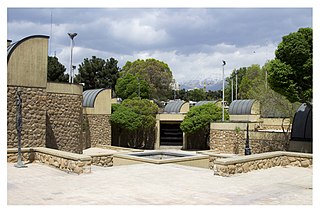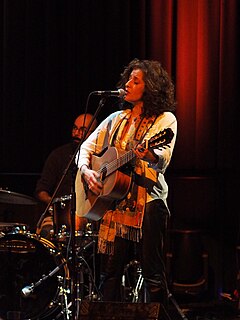Related Research Articles

Tehran Museum of Contemporary Art,, also known as TMoCA, is among the largest art museums in Tehran and Iran. It has collections of more than 3,000 items that include 19th and 20th century's world-class European and American paintings, prints, drawings and sculptures. TMoCA also has one of the greatest collections of Iranian modern and contemporary art.

Shirin Neshat is an Iranian visual artist who lives in New York City, known primarily for her work in film, video and photography. Her artwork centers on the contrasts between Islam and the West, femininity and masculinity, public life and private life, antiquity and modernity, and bridging the spaces between these subjects.

Parvaneh Forouhar née Eskandari was an Iranian dissident and activist who was murdered during the chain murders of Iran in November 1998.

Leila Forouhar is an Iranian pop and classical singer. She was a child star, acting from the age of 3. She is one of the most successful women artists in Iranian society. She relocated to next door Turkey in 1986, then to Paris, before emigrating to Los Angeles in 1988.

Roya Arab is a UK-based Iranian musician and archaeologist. Besides music, she has a passion for all things Iranian/Persian, past and present.
The chain murders of Iran were a series of 1988–98 murders and disappearances of certain Iranian dissident intellectuals who had been critical of the Islamic Republic system. The murders and disappearances were carried out by Iranian government internal operatives, and they were referred to as "chain murders" because they appeared to be linked to each other.
Shadi Ghadirian is an Iranian contemporary photographer. Her work is influenced by her experiences as a Muslim woman living in contemporary Iran, but her work also relates to the lives of women throughout the world. Through her work, she critically comments on the pushes and pulls between tradition and modernity for women living in Iran, as well as other contradictions that exist in everyday life. She explores the topics of censorship, religion, modernity, and the status of women. Ghadirian gained international recognition through the series Qajar and Like Every Day in 1998 and 2001. She is living and working in Tehran.

Bahman Kiarostami is an Iranian film director, cinematographer, film editor and film producer. He is the son of the late critically acclaimed Abbas Kiarostami. The main theme in Kiarostami's films are art and music.
Mohammad Mokhtari was an Iranian writer, poet and left-wing activist. He was an active member of the Iranian Writers Association, a group that had been long banned in Iran due to their objection to censorship and encouraged freedom of expression. Due to his activism, he was most likely murdered during the Chain murders of Iran in December 1998.
Bethan Huws is a Welsh multi-media artist whose work explores place, identity, and translation, often using architecture and text. Her work has been described as "delicate, unobtrusive interventions into architectural spaces".
Haegue Yang (Korean: 양혜규) is a South Korean artist. She lives and works in Berlin and Seoul. Yang often uses standard household objects in her works, and tries to liberate them from their functional context, and apply other connotations and meaning to them. “Linguistic and didactic processes” are central features of her work. Much of Yang’s artworks attempt to provide sensory experiences through abstract narratives.
Parvaneh Soltani is an Iranian playwright, theatre director and actress who lives in London.

Monir Shahroudy Farmanfarmaian was an Iranian artist and a collector of traditional folk art. She is noted for having been one of the most prominent Iranian artists of the contemporary period, and she was the first artist to achieve an artistic practice that weds the geometric patterns and cut-glass mosaic techniques (Āina-kāri) of her Iranian heritage with the rhythms of modern Western geometric abstraction. In 2017, the Monir Museum in Tehran, Iran was opened in her honor.
Sanaz Mazinani is an Iranian–born Canadian multidisciplinary visual artist, curator and educator, known for her photography and installation art. She is currently based in San Francisco and Toronto.
Pilar Albarracín, as a contemporary Spanish artist, Albarracín is known for her performances, video, drawings, photography and interactive sculptural installations "that focus on the cultural construction of Spanish identity, especially that of the Andalusian woman." Curator Rosa Martinez considers Albarracín "one of the most significant artists of the contemporary Spanish scene." Writer Paula Achiaga names her one of the most controversial Spanish artists in a 2014 article.
Annik Shefrazian, known mononymously as Annik was an Iranian Armenian actress of film and television.
Rana Javadi (Persian: رعنا جوادی, born 1953 is an Iranian photographer and museum founder.
Saeed Bashirtash is an Iranian politician and dentist and implant surgeon who lives in Brussels, Belgium. He is an activist in opposition of the current government of the Islamic Republic of Iran.

Shaheen Merali is a Tanzanian writer, curator, critic, and artist. Merali began his artistic practice in the 1980s committing to social, political and personal narratives. As his practice evolved, he focused on functions of a curator, lecturer and critic and has now moved into the sphere of writing. Previously he was a key lecturer at Central Saint Martins School of Art (1995-2003), a visiting lecturer and researcher at the University of Westminster (1997-2003) and the Head of the Department of Exhibition, Film and New Media at the Haus der Kulturen der Welt, Berlin (2003-2008). A regular speaker on ideas of contemporary exhibition making internationally, in 2018 he was the keynote speaker at the International Art Gallery of the Aga Khan Diamond Jubilee Arts Festival, Lisbon.
References
- 1 2 3 Parastou, Foruhar (2010). Parastou Forouhar: Art, Life and Death in Iran. London,UK: Saqi Books. p. 6. ISBN 978-0-86356-448-2.
- ↑ "Parastou Forouhar | Feminist Art Archive". courses.washington.edu. Retrieved 2016-03-05.
- 1 2 Forouhar, Parastou. "Vita". Archived from the original on 3 March 2016. Retrieved 1 February 2014.
- 1 2 Lauren. "Parastou Forouhar". Feminist Art Archive. Retrieved 5 March 2016.
- ↑ culturebase.net. "Parastou Forouhar artist portrait - culturebase.net". www.culturebase.net. Retrieved 2017-04-24.
- ↑ Forouhar, Parastou (2010). Parastou Forouhar: Art,Life, and Death in Iran. lONDON, uk: SAQI. p. 5. ISBN 978-0-86356-448-2.
- ↑ "TREIBSAND". TREIBSAND (in Swiss High German). Retrieved 2017-10-05.
- ↑ "Parastou FOROUHAR". www.piartworks.com. Retrieved 2017-04-24.
- 1 2 3 Maura Reilly, Linda Nochlin, ed. (2007). Global Feminisms. London: Merrell Publishers Limited. p. 273. ISBN 978-1-8589-4390-9.
- ↑ "Artist from Iran wins Sophie von La Roche award - BBC News". BBC News. Retrieved 2016-03-05.
- ↑ "Parastou Forouhar - 10 Artworks, Bio & Shows on Artsy". www.artsy.net. Retrieved 2017-04-24.